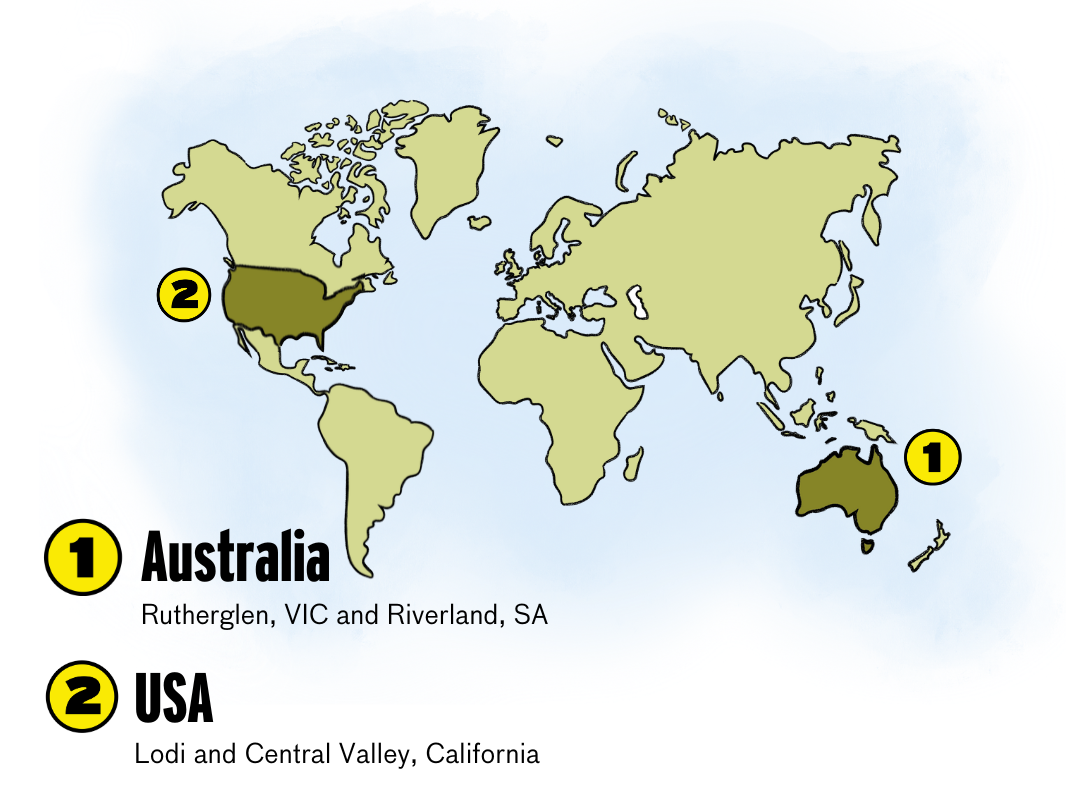

The red you need after a day ploughing fields in the rain.
TL; DR
Durif is the big, bold red you need after a day ploughing the fields in the rain.
So, what is Durif all about?--red
Durif (pronounced “dioo-riff”) is a crossing between Syrah (also known as Shiraz) and the rare variety Peloursin. It’s also known as Petite Sirah, so called because of the size of its little berries. But don’t be fooled by that picture of cuteness as it’s a big, bold, ‘take-no-prisoners’ kind of variety, deeply coloured and rich with black fruit flavours, spice and black pepper. And because of its inky colour, Durif contains high levels of antioxidants, which are apparently excellent for blasting any unstable free radicals you may have acquired along the way!

Where does Durif come from?--earth
From the south of France, it was first discovered in the 1860s in the Isére in eastern France.
Who's famous for Durif?--racy
Durif loves heat! Loves it! It’s also drought-tolerant and doesn’t shrivel up like a sweet sultana when it’s left on the vine for ripening while keeping acidity high. That ultimately means it’s perfect in warm climates like Australia’s Rutherglen and Riverland regions, Lodi and Central Valley in California. Also, in Israel, Durif is celebrated for holding onto acidity, even in the hottest/driest summers, which helps produce much more balanced wines.

What does Durif taste like?--aromatic
Durif offers up aromas of mostly black fruit flavours, ranging from blackberry and blueberry, to slightly deeper black cherries and black plums. It is generally intense and inky, and being a late-ripening variety, spends additional time on the vine concentrating the flavours. There’s a hint of black pepper spice and herbal notes, too, and you’ll often see vanilla, cedar and other oaky flavours and high levels of tannin.

How is Durif made?--cellar
Taming the tendency for Durif to be a bit burly and rough is always a goal, with extended oak ageing helping to soften Durif’s edges pretty common. You’ll sometimes see Durif released a little later than other red wines too, again too soften up nicely.
What are the different Durif styles?--lemon
Because of Durif’s ability to ripen with high levels of sugar and tannin, it was originally used for fortified wine production in Australia. Still, nowadays, it’s made into dry, full-bodied and robust table wines and bold sparkling reds. These are usually high in alcohol, too, as well as all that grippy tannin!
What foods should you pair with Durif?--plum
A big, bold red such as this requires a big, bold dish - think winter/ fire/ Aran jumpers/ meaty braises to make your teeth straight and your hair curly… oxtail stew, osso buco and Lancashire hotpot will work a treat, or try venison or kangaroo fillets with a veal stock reduction. A vegetarian moussaka or even a wedge of crumbly aged Cheddar would be wonderful too.

Recipes to pair with Durif--pizza

Fun fact about Durif--eggplant
Durif was named in 1868 after the French botanist François Durif, who was responsible for cross-pollinating the grape - like, he actually invented it! It was originally called Plant du Rif. Cute.
If you like this, you should also give these grapes a guzzle...--wines
About the Author:
Andrew Graham is a master winemaker and viticulturist (aka a grape guy) who fell into the wine industry as a teenager and never looked back! Voted the 23rd most trusted wine critic on the planet, Andrew judges at wine shows across the globe and runs foolishly long ultramarathons in his spare time (swiftly followed by a recuperative glass of wine or a frosty beer).
Do you know your wine personality? If your answer is no, take our quiz to find out which wines to pick up next and build your box!
Build my box





